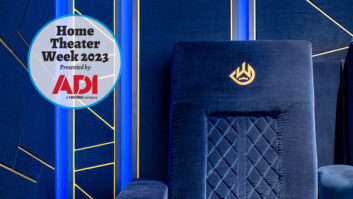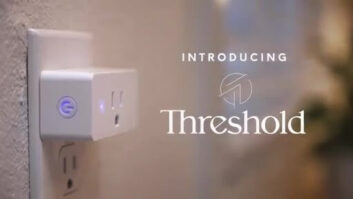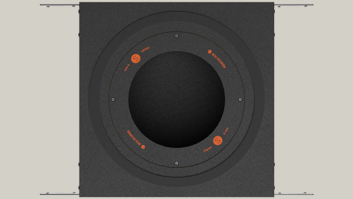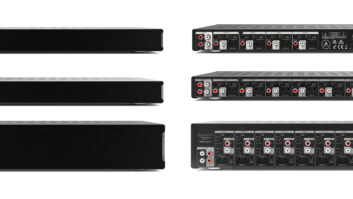I’m going to start this review by stepping back in time a bit…
Think back to the days of the epic CEDIA booth, when Runco reigned like a returning king and would pair with giants like Krell and Stewart and California Audio Technology (CAT) to build virtual cities that would then show the most amazing 15-minute demos at the CEDIA EXPO. People would line up like it was a ride at Disneyland, and then wait hours to get a shot at seeing one of these killer demos.
Many of these demonstrations included D-BOX motion seating, which featured advanced electronics and power actuators that moved them in coordination with the action on screen; a car would take a hard turn and the D-BOX seat would pitch to the left. A character would nearly fall over a cliff and you would be jolted forward in your seat.
Back then, to be frank, I pretty much hated this type of experience. I found the effect distracting and so overdone that it completely pulled me out of the movie and left me feeling a bit nauseous; like I had been sitting on the deck of a boat in a storm, pitching and yawing. And that was after only 15 minutes. I couldn’t imagine a two-hour movie like that.
Fast-forward a bit in time and we come to the CES this past January where a consortium of manufacturers combined to give “The Unforgettable Home Theater Experience.” Among these manufacturers was D-BOX.
At first I was a bit leery, but I was told that they had made some adjustments to the system and that I should give it another try. And after sitting through the demo—which included a lengthy clip from The Empire Strikes Back—I was a long way toward being a convert.
D-BOX’s Mario Thibeault told me that for years manufacturers and dealers had been demoing the system incorrectly. To ensure that people really felt the system in action and got a gee-whiz 2-minute demo, they turned the motion effect to maximum, akin to playing a subwoofer with the volume knob cranked to 11. But, with the effect dialed down to a more realistic level, the D-Box seating added an extra layer of enjoyment to the movie-watching experience. The subtle sway and tilting and rumbling as you watched the snowspeeders take on the AT-AT walkers in “Empire” really made you feel a part of the on-screen action.
So, jump cut ahead to last June and the manager of the local Frank’s movie theater chain came into my custom install showroom one Saturday afternoon. He’s looking for DVI-to-HDMI cable changers for the theater, and I happened to have the parts he needed. We chatted for a bit and he mentioned that his theater had just been outfitted with some new kind of seating; seats that move.
“Seats that move? Are they by D-BOX?” I ask.
“Yeah. Have you heard of them?”

D-BOX’s demo in lobby of the Frank Theaters lobby in Murrells Inlet, SC. It turns out that D-BOX has been teaming with a handful of theaters across the country (you can check the map here to see if there is an equipped theater near you) and shockingly they had a theater a scant four miles from my showroom in Murrells Inlet, SC, as one of the sites. After talking for a while, the manager invited me to come in and take the chairs for a spin.
“We’re currently showing Snow White and the Huntsman, but next month it will be Spiderman,” he told me.
“Cool, “I said. “I’ll see you next month!”
So, yesterday I took a trip down to the Frank Theaters with my wife, Dana, for the 4:50 showing of The Amazing Spiderman in 3D and a “ride” in D-BOX’s MFX seating. When we arrived at the theater, a special D-BOX poster greeted us just prior to entering.

When we arrived at the theater, a special D-BOX poster greeted us just prior to entering.
A brief explanation of D-Box’s technology is probably in order. According to its website, “Motion editing is a new art form, a new sophisticated discipline where art meets technology meets cinema. It leads to the rise of MFX, a multi-sensorial revolution in movie-watching and gaming. Action becomes motion. Sounds become motion. Events become motion. All of this MFX fun is made possible by our patented, award-winning D-BOX technology. Only D-BOX offers you MFX using 3 types of intelligent movement (subtle pitch, roll and heave) to move you gently forwards and backwards, from side to side and up & down. Combine that with the D-BOX-encoded intelligent vibrations and it all comes together to create the most amazing, all-encompassing entertainment experience ever.”
D-BOX’s Thibeault said, “Forget the motion; we provide reality. The experience of being in the movies. Period. Systems without D-Box are like watching movies in black and white with mono sound.”
Sounds pretty cool, right? Well, that’s what I was here to find out.
In the lobby in front of the concessions area was a fairly elaborate D-Box demo system. The system included a flat panel TV, audio system, and two D-Box seats.

In the lobby in front of the concessions area was a fairly elaborate D-Box demo system. The system included a flat panel TV, audio system, and two D-Box seats:.
There weren’t too many people milling about the lobby, but I did notice a few people trying out the demo setup which included scenes from Spiderman. The people that made any comment usually said, “Cool!”
The D-Box experience adds a pretty hefty—$8—premium to the price of a regular ticket, meaning that an evening showing of Spiderman in 3D would run you $19 locally. The manager said that he didn’t think that Snow White was really the best movie to start it off with, but that the feedback on Spiderman has been very positive and that “they’ve sold a lot of tickets” to view the movie in D-Box.
Inside the theater, two rows of conventional seats have been replaced with D-Box motion seating, making for a total of 26 D-Box seats.

Inside the theater, two rows of conventional seats have been replaced with D-Box motion seating, making for a total of 26 D-Box seats.
When a D-Box ticket is purchased, you are assigned a specific D-Box seat, which is then activated. So, even if the theater is empty, sitting in one of the D-Box seats won’t give you the experience if you haven’t paid for it or if you are sitting in the wrong seat. (Also, the D-Box seats don’t allow you to rock like the regular seats do, so if you aren’t enjoying the motion, then the regular chairs are probably more comfortable anyhow…)
Rest assured, the D-Box seats do have cupholders big enough to handle a large drink and deep enough to ensure that said drink won’t go flying out in the middle of an intense action sequence. I purchased a large combo just to ensure such a thing. (The lengths I go to…)

Rest assured, the D-Box seats do have cupholders big enough to handle a large drink and deep enough to ensure that said drink won’t go flying out in the middle of an intense action sequence.
When the lights drop, a cool D-Box fighter jet trailer comes on and the seats come to life along with a note on the screen that says if you are sitting in a D-Box seat, now is the time to adjust the level. Down by your right thigh is a level adjustment offering three settings of motion intensity. It’s great that each chair offers individual adjustment as Dana liked hers set on maximum—“If you pick your feet up off the floor, it really feels like you’re going somewhere!” she said—and I toggled mine between the minimum and medium settings (and wished there had been a setting that fell right in between the two levels).
Because the coding is carefully scripted specifically for each film, the experience for each movie would be different, but even during a big action film like Spiderman, the seats remain still for the majority of the film. This is nice because it doesn’t take away from dialog or become a distraction. I found the seats comfortable, reminding me a bit of the seat in a sports car; stiff, but with good support and side bolsters.
The seats really come to life during action sequences; responding to big hits, impacts, and explosions with a nice tactile sensation that either felt like a rattle or a boom—depending on what the scene called for–that was a great companion to the subwoofers. In fact, I wish there had been a way to turn this effect up, while leaving the actual motion part at a more minimal setting.
There was a cool moment during the opening credits when the seats pitched forward and then were snapped back to correspond to a web slinging out and snatching the letters on screen. The big Williamsburg Bridge scene offered tons of motion excitement, as did Spiderman swinging across the city on his webs, and, of course, the big battle scenes between Spiderman and Lizard, uh, man.
After it was over, I thought that it definitely added something to the film and I was already thinking about how cool it would be to see The Dark Knight Rises–the next film to take advantage of the D-Box seating–in D-Box. But I wanted to see what other people thought.

John and Dana Sciacca enjoy their private screening of Spiderman, in D-BOX seats.
So, I polled every…single…person in the theater. OK. That was really pretty easy, since it was literally just my wife and I in the movies. So, I asked her some questions.
John: “Have you ever heard of D-Box before?”
Dana: “I don’t think so.”
John “So this means that you haven’t been listening when I was telling you about the things I saw at tradeshows I guess, because I clearly remember talking about the demo at CES…”
Dana: (Silence)
John: “With Star Wars…”
Dana: (Silence)
John: “OK. So, what did you think of the experience?”
Dana: “I enjoyed it a lot. It feels like you’re a part of the movie—like you’re in the action, along with the 3D. I’m not sure that it would be as good without the 3D; the two effects seem to work well and complement each other.”
John: “Would you like to have a system like that at home?”
Dana: “I’m not sure I would want to watch every movie in it; it was mainly the action scenes that it added to the experience. It’s not like I need to watch Pride and Prejudice with it.”
John: “Or watch it at all…”
Dana: “What?”
John: “Huh? Nothing. So, last question, how much would you pay as a premium for the experience?”
Dana: “Maybe I’d pay $5 extra. My husband is pretty cheap so…”
John: “OK! Interview over!”
For years, commercial cinema has been looking for ways to continue to entice moviegoers to come back. Between larger screens, bigger sound and 3D, the commercial movie houses continue to look for ways to improve the experience and offer something that you can’t get at home. And, with a D-Box system costing upwards of $10,000 for a residential model, an $8 ticket premium seems a small price to pay for a pretty cool experience.







